2014 年 6 月英语六级真题(二)
Part I
Directions: Forthispart,youareallowed30minutestowriteanessayexplainingwhyitisunwise
to put all your eggs in one basket. You can give examples to illustrate your point.
You should write at least 150 words but no more than 200 words.
(30 minutes)
Writing
Listening
(30 minutes)
Comprehension
Part II
Section A
Directions: In this section, you will hear 8 short conversations and 2 long conversations. At
theendofeachconversation,oneormorequestionswillbeaskedaboutwhatwassaid.
Boththeconversationandthequestionswillbespokenonlyonce.Aftereachquestion
therewillbeapause.Duringthepause,youmustreadthefourchoicesmarkedA),B),
C) and D), anddecide which is thebest answer. Then markthe corresponding letter on
Answer Sheet 1 with a single line through the centre.
注意:此部分试题请在答题卡 1 上作答。
1. A. College tuition has become a heavy burden for the students.
B. College students are in general politically active nowadays.
C. He is doubtful about the effect of the students’ action.
D. He took part in many protests when he was at college.
2. A. Jay is organizing a party for the retiring dean.
B. Jay is surprised to learn of the party for him.
C. The dean will come to Jay’s birthday party.
D. The class has kept the party a secret from Jay.
3. A. He found his wallet in his briefcase.
B. He went to the lost-and-found office.
C. He left his things with his car in the garage.
D. He told the woman to go and pick up his car.
4. A. The show he directed turned out to be a success.
B. He watches only those comedies by famous directors.
C. New comedies are exciting, just like those in the 1960s.
D. TV comedies have not improved much since the 1960s.
5. A. All vegetables should be cooked fresh.
B. The man should try out some new recipes.
C. Overcooked vegetables are often tasteless.
D. The man should .stop boiling the vegetables.
6. A. Sort out their tax returns.
B. Help them tidy up the house.
C. Figure out a way to avoid taxes.
D. Help them to decode a message.
7. A. He didn’t expect to complete his work so soon.
B. He has devoted a whole month to his research.
C. The woman is still trying to finish her work.
D. The woman remains a total mystery to him.
�
8. A. He would like to major in psychology too.
B. He has failed to register for the course.
C. Developmental psychology is newly offered.
D. There should be more time for registration.
Questions 9 to 11 are based on the conversation you have just heard.
9. A. The brilliant product design.
B. The new color combinations.
C. The unique craftsmanship.
D. The texture of the fabrics.
10. A. Unique tourist attractions.
B. Traditional Thai silks.
C. Local handicrafts.
D. Fancy products.
11. A. It will be on the following weekend.
B. It will be out into the countryside.
C. It will last only one day.
D. It will start tomorrow.
Questions 12 to 15 are based on the conversation you have just heard.
12. A. A good secondary education.
B.A pleasant neighbourhood.
C. A happy childhood.
D. A year of practical training.
13. A. He ought to get good vocational training.
B. He should be sent to a private school.
C. He is academically gifted.
D. He is good at carpentry.
14. A. Donwell School.
B. Enderby High.
C. Carlton Abbey
D. Enderby Comprehensive.
15. A. Put Keith in a good boarding school.
B. Talk with their children about their decision.
C. Send their children to a better private school.
D. Find out more about the five schools.
Section B
Directions: Inthissection,youwillhear3shortpassages.Attheendofeachpassage,youwill
hearsomequestions.Boththepassageandthequestionswillbespokenonlyonce.After
you heara question,you must choose thebestanswer from thefour choices marked A),
B),C)andD).ThenmarkthecorrespondingletteronAnswerSheet1withasingleline
through the centre.
�
Passage One
Questions 16 to 18 are based on the passage yon have just heard.
16. A. It will be brightly lit.
B. It will be well ventilated.
C. It will have a large space for storage.
D. It will provide easy access to the disabled.
17. A. On the first floor.
B. On the ground floor.
C. Opposite to the library.
D. On the same floor as the labs.
18. A. To make the building appear traditional.
B. To match the style of construction on the site.
C. To cut the construction cost to the minimum.
D. To embody the subcommittee’s design concepts.
Passage Two
Questions 19 to 22 are based on the passage you have just heard.
19. A. Sell financial software.
B. Train clients to use financial software.
C. Write financial software.
D. Conduct research on financial software.
20. A. Unsuccessful.
B. Tedious.
C. Rewarding.
D. Important.
21. A. He offered online tutorials.
B. He held group discussions.
C. He gave the trainees lecture notes.
D. He provided individual support.
22. A. The employees were a bit slow to follow his instruction.
B. The trainees’ problems had to be dealt with one by one.
C. Nobody is able to solve all the problems in a couple of weeks.
D. The fault might lie in his style of presenting the information.
Passage Three
Questions 23 to 25 are based on the passage you have just heard.
23. A. Their parents tend to overprotect them.
B. Their teachers meet them only in class.
C. They have little close contact with adults.
D. They rarely read any books about adults.
24. A. Real-life cases are simulated for students to learn law.
B. Writers and lawyers are brought in to talk to students.
C. Opportunities are created for children to become writers.
D. More Teacher and Writer Collaboratives are being set up.
�
25. A. Sixth-graders can teach first-graders as well as teachers.
B. Children are often the best teachers of other children.
C. Paired Learning cultivates the spirit of cooperation.
D. Children like to form partnerships with each other.
Section C
Directions: In this section, you will hear a passage three times. When the passage is read for
the first time, you should listen carefully for its general idea. When the passage
isreadforthesecondtime,youarerequiredtofillintheblankswiththeexactwords
you havejust heard.Finally, whenthe passageis read for thethird time, youshould
check what you have written.
注意:此部分试题请在答题卡上作答。
Tests may be the most unpopular part of academic life. Students hate them because they produce
about being evaluated, and a focus on grades instead of learning for learning’s
26
fear and
sake.
But tests are also valuable. A well-constructed test
27
need to learn. Tests help you see how your performance
you’ll be tested on
thoroughly.
material is certainly likely to
29
28
what you know and what you still
that of others. And knowing that
you to learn the material more
30
However, there’s another reason you might dislike tests. You may assume that tests have the
your worth as a person. If you do badly on a test, you may be tempted to believe
information about yourself from the professor, information that
power to
that you’ve received some
says you’re a failure in some significant way.
31
32
33
This is a dangerous--and wrong-headed--assumption. If you do badly on a test, it doesn’t
mean you’re a bad person or stupid. Or that you’ll never do better again, and that your life
is
If you don’t do well on a test, you’re the same person you were before you took
the test--no better, no worse. You just did badly on a test. That’s it.
, tests are not
a measure of your value as an individual--they are a measure only of how well and how much you
studied. Tests are tools; they are indirect and
measures of what we know.
34
35
Reading
(40 minutes)
Comprehension
Part III
Section A
Directions: In this section,there is a passage with tenblanks. You are required to select one
wordforeachblankfromalistofchoicesgiveninawordbankfollowingthepassage.
Readthepassagethroughcarefullybeforemakingyourchoices.Eachchoiceinthebank
isidentifiedbyaletter.PleasemarkthecorrespondingletterforeachitemonAnswer
Sheet2withasinglelinethroughthecentre.Youmaynotuseanyofthewordsinthe
bank more than once.
Questions 36 to 45 are based on the following passage.
Fear can be an effective way to change behavior. One study compared the effects of high-fear
and low-fear appeals on changes in attitudes and behaviors related to dental hygiene (卫生). One
group of subjects was shown awful pictures of
teeth and diseased gums; another group was
shown less frightening materials such as plastic teeth, charts, and graphs. Subjects who saw the
to change the way they took care
frightening materials reported more anxiety and a greater
36
37
�
of their teeth than the low-fear group did.
38
But were these reactions actually
into better dental hygiene practices? To answer
this important question, subjects were called back to the laboratory on two
(five days
and six weeks after the experiment). They chewed disclosing wafers (牙疾诊断片) that give a red
stain to any uncleaned areas of the teeth and thus provided a direct
of how well they were
really taking care of their teeth. The result showed that the high-fear appeal did actually result
in greater and more
to high-fear
warnings brushed their teeth more
changes in dental hygiene. That is, the subjects
than did those who saw low-fear warnings.
40
39
42
41
43
However, to be an effective persuasive device it is very important that the message not be
too frightening and that people be given
guidelines to help them to reduce the cause of
the fear. If this isn’t done, they may reduce their anxiety by denying the message or the
45
of the communicator. If that happens, it is unlikely that either attitude or behavior change will
occur.
注意:此部分试题请在答题卡 2 上作答。
44
A) accustomed
B) carefully
C) cautiously
D) concrete
E) credibility
F) decayed
G) desire
H) dimensions
I) eligible
J) exposed
K) indication
L) occasions
M) permanent
N) sensitivity
O) translated
Section B
Directions: Inthissection,youaregoingtoreadapassagewithtenstatementsattachedtoit.
Each statement contains information given in one of the paragraphs. Identify the
paragraphfromwhichtheinformationisderived. Youmaychooseaparagraphmorethan
once. Each paragraph is marked with a letter. Answer the questions by marking the
corresponding letter on .Answer Sheet 2.
The Street-Level Solution
A) When I was growing up, one of my father’s favorite sayings (borrowed from the humorist Will
Rogers) was: “It isn’t what we don’t know that causes the trouble; it’s what we think we
know that just ain’t so. “One of the main insights to be taken from the 100 000 Homes Campaign
and its strategy to end chronic homelessness is that, until recently, our society thought it
understood the nature of homelessness, but it didn’t.
B) That led to a series of mistaken assumptions about why people become homeless and what they
need. Many of the errors in our homelessness policies have stemmed from the conception that
the homeless are a homogeneous group. It’s only in the past 15 years that organizations like
Common Ground, and others, have taken a street-level view of the problem--distinguishing the
“episodically homeless” from the, “chronically homeless” in order to understand their needs
at an individual level. This is why we can now envisage a different approach--and get better
results.
�
C) Most readers expressed support for the effort, although a number were skeptical, and a few
utterly dismissive, about the chances of long-term homeless people adapting well to housing.
This is to be expected; it’s hard to imagine what we haven’t yet seen. As Niccolò Machiavelli
wrote in The Prince, one of the major obstacles in any effort to advance systemic change is
the “incredulity of men,” which is to say that people “do not readily believe in new things
until they have had a long experience of them.” Most of us have witnessed homeless people
on the streets for decades. Few have seen formerly homeless people after they have been housed
successfully. We don’t have reference points for that story. So we generalize from what we
know--or think we know.
D) But that can be misleading, even to experts. When I asked Rosanne Haggerty, founder of Common
Ground, which currently operates 2,310 units of supportive housing (with 552 more under
construction), what had been her biggest surprise in this work, she replied: “Fifteen years
ago, I would not have believed that people who had been so broken and stuck in homelessness
could thrive to the degree that they do in our buildings.” And Becky Kanis, the campaign’s
director, commented: “There is this sense in our minds that someone who’s on the streets
is almost in their DNA different from someone who has a house. The campaign is creating a
first-hand experience for many people that that is really not the case.”
E) One of the startling realizations that I had while researching this column is that anybody
could become like a homeless person--all it takes is a traumatic (创伤的) brain injury. A bicycle
fall, a car accident, a slip on the ice, or if you’re a soldier, a head wound--and your life
could become unrecognizable. James O’Connell, a doctor who has been treating the most
vulnerable homeless people on the streets of Boston for 25 years, estimates that 40 percent
of the long-term homeless people he’s met had such a brain injury. “For many it was a head
injury prior to the time they became homeless,” he said. “They became unpredictable. They’d
have mood swings, fits of explosive behavior. They couldn’t hold onto their jobs. Drinking
made them feel better. They’d end up on the streets.”
F) Once homeless people return to housing, they’re in a much better position to rebuild their
lives. But it’s important to note that housing alone is not enough. As with many complex social
problems, when you get through the initial crisis, you have another problem to solve which
is no less challenging. But it is a better problem.
G) Over the past decade, O’Connell has seen this happen. “I spend half my time on the streets
or in the hospital and the other half making house calls to people who lived for years on the
streets,” he said. “So from a doctor’s point of view it’s a delightful switch, but it’s
not as if putting someone in housing is the answer to addressing all of their problems. It’s
the first step.”
H) Once in housing, formerly homeless people can become isolated and lonely. If they’ve lived
on the streets for years, they may have acquired a certain standing as well as a sense of pride
in their survival skills. Now indoors, those aspects of their identity may be stripped away.
�
Many also experience a profound disorientation at the outset. “If you’re homeless for more
than six months, you kind of lose your bearings,” says Haggerty. “Existence becomes not about
overcoming homelessness but about finding food, begging, looking for a job to survive another
day. The whole process of how you define stability gets reordered.”
I) Many need regular, if not continuous, support with mental health problems, addictions and
illnesses-and, equally important, assistance in the day-to-day challenges of life,
reacquainting with family, building relationships with neighbors, finding enjoyable activities
or work, managing finances, and learning how to eat healthy food.
J) For some people, the best solution is to live in a communal (集体) residence, with special
services. This isn’t available everywhere, however. In Boston, for example, homeless people
tend to be scattered in apartments throughout the city.
K) Common Ground’s large residences in New York offer insight into the possibilities for change
when homeless people have a rich array of supports. In addition to more traditional social
services, residents also make use of communal gardens, classes in things like cooking, yoga,
theatre and photography, and job placement. Last year, 188 formerly homeless tenants in four
of Common Ground’s residences, found jobs.
L) Because the properties have many services and are well-managed, Haggerty has found post-housing
problems to be surprisingly rare. In the past 10 years, there have been only a handful of
incidents of quarrels between tenants. There is very little graffiti (破坏) or vandalism (涂
鸦). And the turnover is almost negligible. In the Prince George Hotel in New York, which is
home to 208 formerly homeless people and 208 low-income tenants, the average length of tenancy
is close to seven years. (All residents pay 30 percent of their income for rent for the formerly
homeless, this comes out of their government benefits.) When people move on, it is usually
because they’ve found a preferable apartment.
M) “Tenants also want to participate in shaping the public areas of the buildings,” said Haggerty.
“They formed a gardening committee. They want a terrace on the roof. Those are things I didn’t
count on.” The most common tenant demand? “People always want more storage space--but that’s
true of every New Yorker,” she adds. “In many ways, we’re a lot like a normal apartment
building. Our tenants look like anyone else.”
N) As I mentioned, homelessness is a catch-all for a variety of problems. A number of readers
asked whether the campaign will address family homelessness, which has different causes and
requires a different solution. I’ve been following some of the promising ideas emerging to
address and prevent family homelessness. Later in 2011, I’ll explore these ideas in a column.
For now, l’11 conclude with an update on the 100,000 Homes Campaign. Since Tuesday, New Orleans
and a few other communities have reported new results. The current count of people housed is
7,043.
注意:此部分试题请在答题卡 2 上作答。
46. Tenants in Common Ground’s residences all want more room for storage.
�
47. Homes Campaign provides first-hand proof that the homeless are not what they were once believed
to be.
48. Common Ground’s residences are well-managed and by and large peaceful.
49. Housing the homeless is only the first step to solving all their problems.
50. A large percent of the chronically homeless have suffered from brain injury.
51. After being housed many homeless people become confused at first as to how to deal with life
off the street.
52. Some people think the best way to help the homeless is to provide them with communal housing.
53. The homeless with health problems should be given regular support in their daily lives.
54. Until recently American society has failed to see what homelessness is all about.
55. Many formerly homeless tenants in New York’s Common Ground’s residences got hired.
Section C
Directions: There are2 passagesin thissection.Eachpassage isfollowedby somequestions or
unfinished statements. For each of them there are four choices marked A), B), C) and
D). You should decide on the best choice and mark the corresponding letter on Answer
Sheet 2 with a single line through the centre.
Passage One
Questions 56 to 60 are based on the following passage.
Technology can make us smarter or stupider, and we need to develop a set of principles to
guide our everyday behavior and make sure that tech is improving and not hindering our mental
processes. One of the big questions being debated today is: What kind of information do we need
to have stored in our heads, and what kind can we leave “in the cloud,” to be accessed as necessary?
An increasingly powerful group within education are championing “digital literacy”. In
their view, skills beat knowledge, developing “digital literacy” is more important than learning
mere content, and all facts are now Google-able and therefore unworthy of committing to memory.
But even the most sophisticated digital literacy skills won’t help students and workers navigate
the world if the), don’t have broad base of knowledge about how the world actually operates.
If you focus on the delivery mechanism and not the content, you’re doing kids a disservice.
Indeed, evidence from cognitive science challenges the notion that skills can exist
independent of factual knowledge. Data from the last thirty years leads to a conclusion that is
not scientifically challengeable: thinking well requires knowing facts, and that’s true not only
because you need something to think about. The very processes that teachers care about
most-critical thinking processes-are intimately intertwined (交织) with factual knowledge that
is stored in long-term memory.
In other words, just because you can Google the date of Black Tuesday doesn’t mean you
understand why the Great Depression happened or how it compares to our recent economic slump.
There is no doubt that the students of today, and the workers of tomorrow, will need to innovate,
collaborate and evaluate. But such skills can’t be separated from the knowledge that gives rise
to them. To innovate, you have to know what came before. To collaborate, you have to contribute
knowledge to the joint venture. And to evaluate, you have to compare new information against
knowledge you’ve already mastered.
So here’s a principle for thinking in a digital world, in two parts. First, acquire a base
of factual knowledge in any domain in which you want to perform well. This base supplies the
�
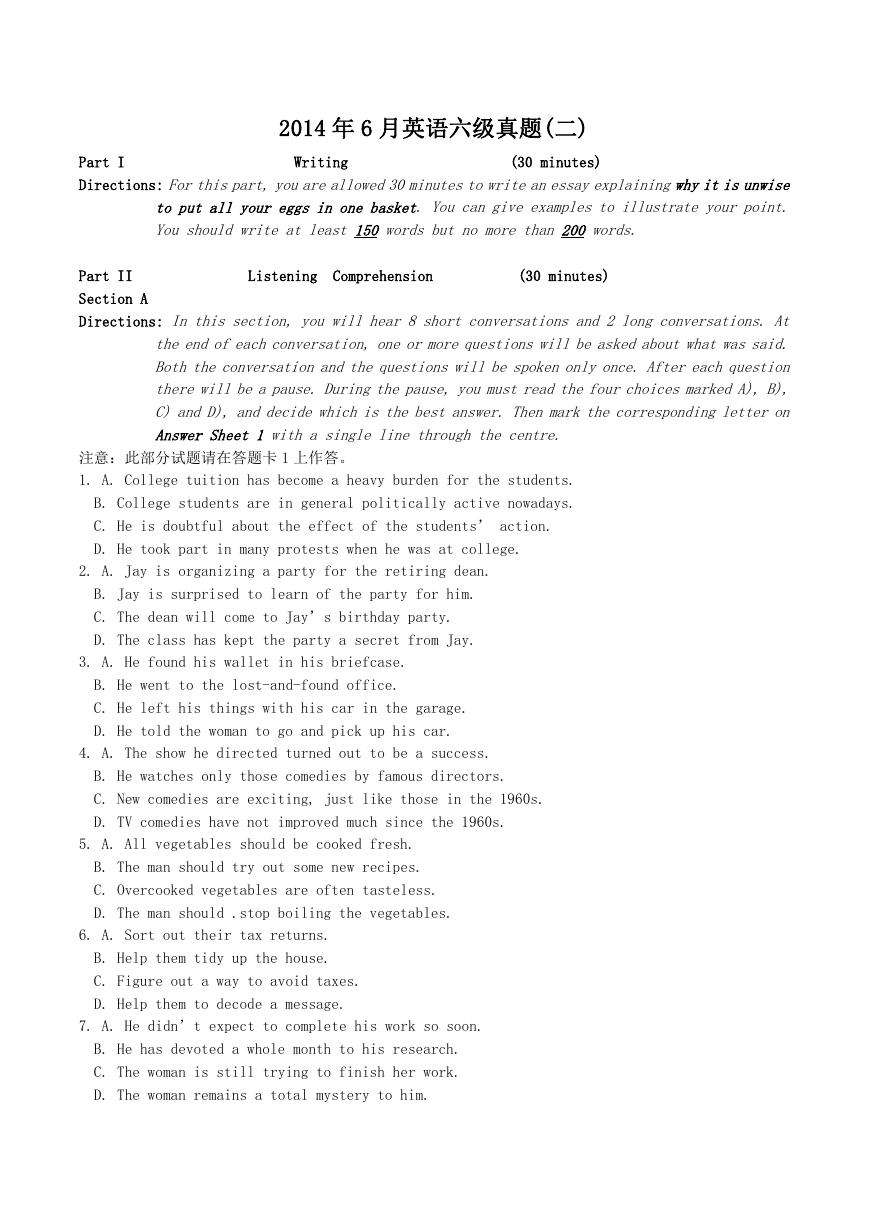
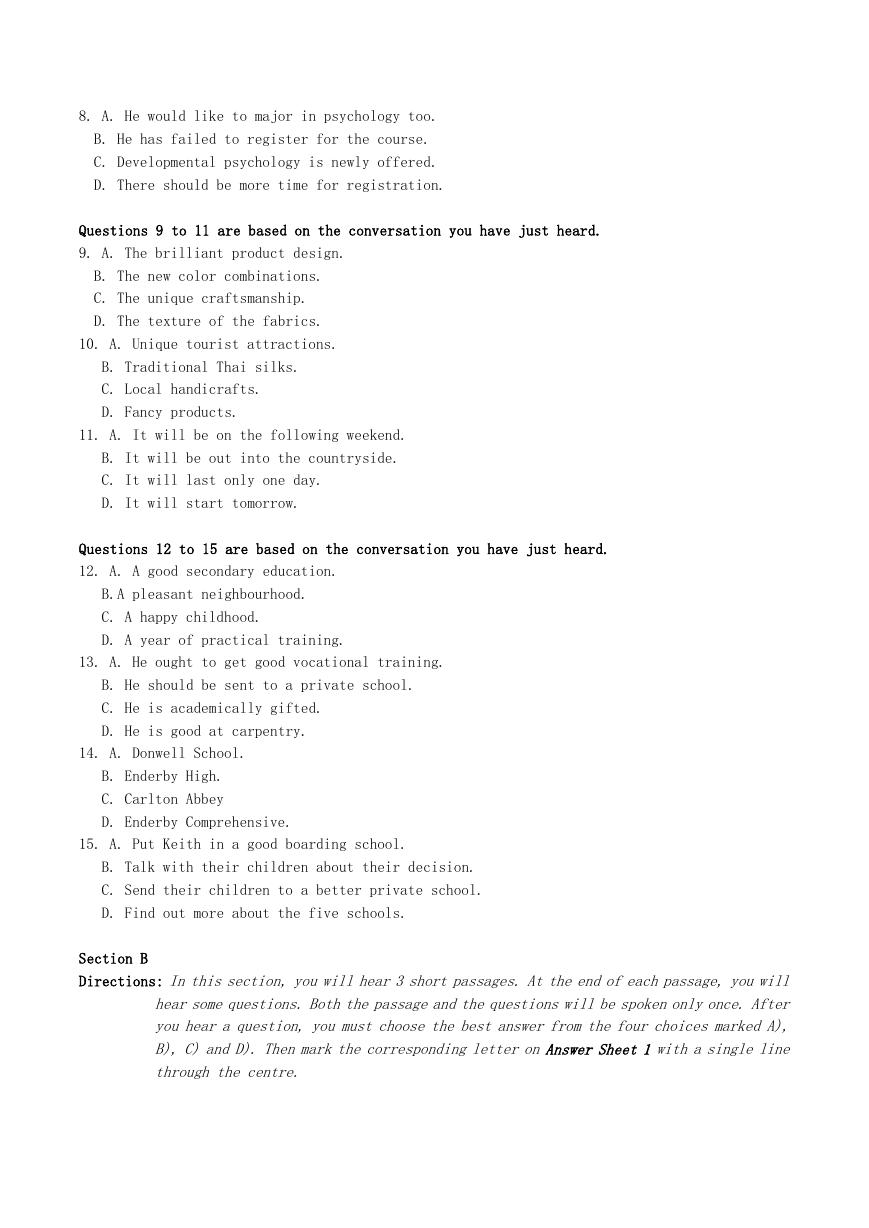
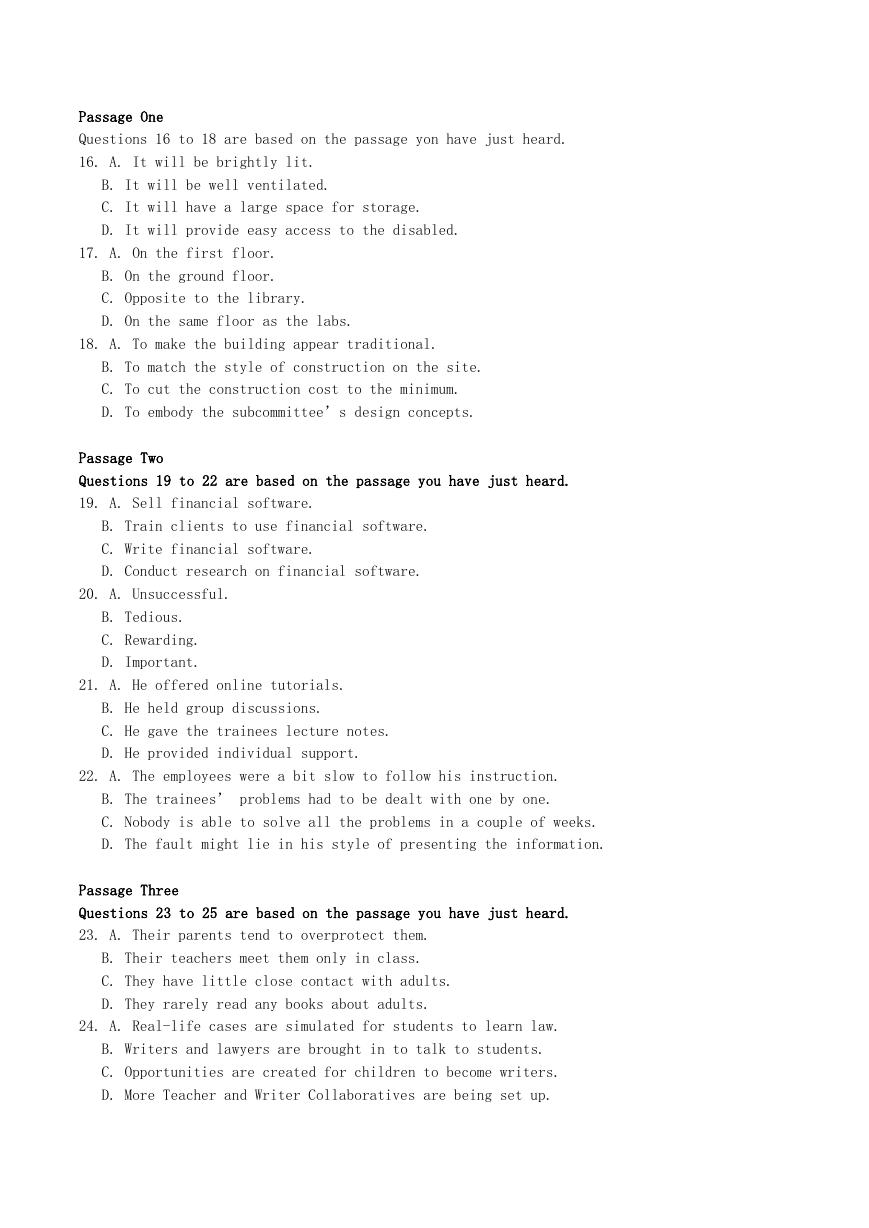
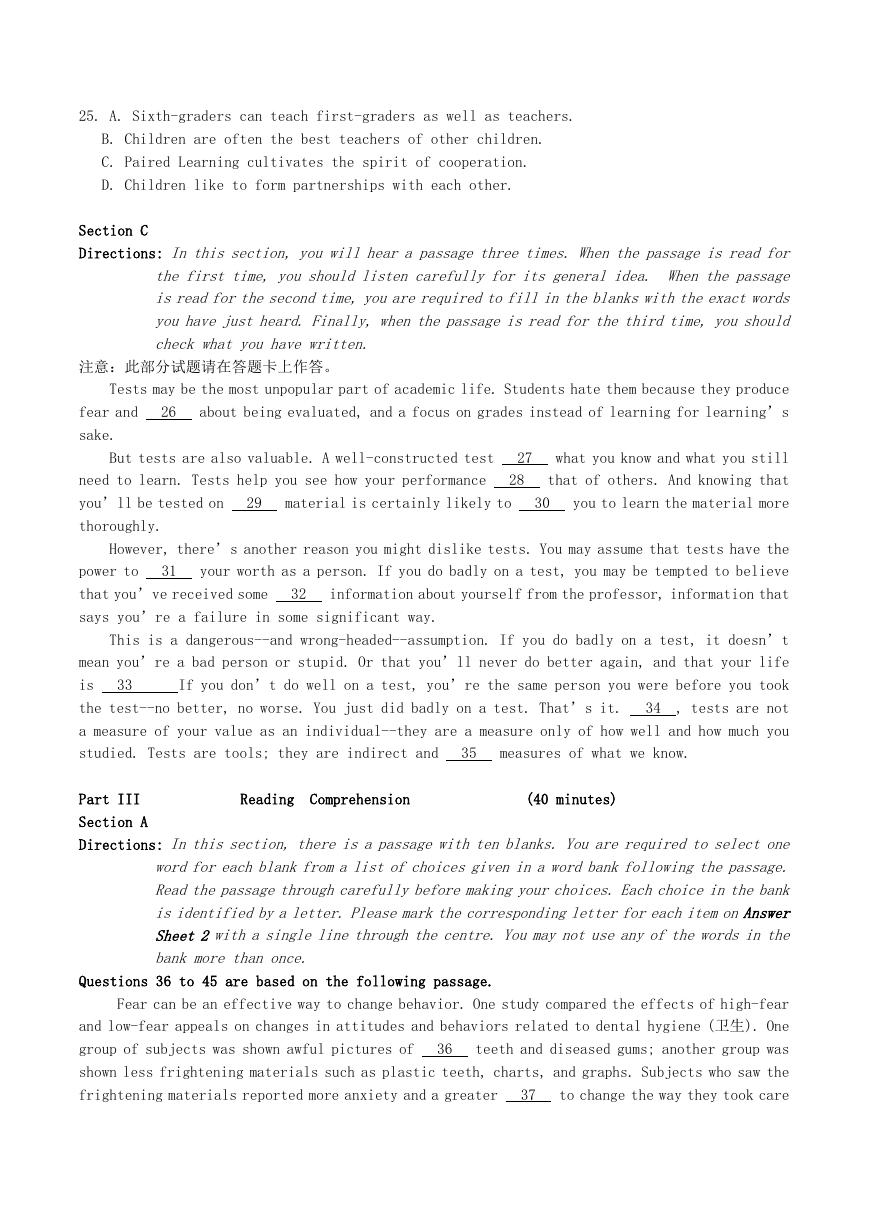

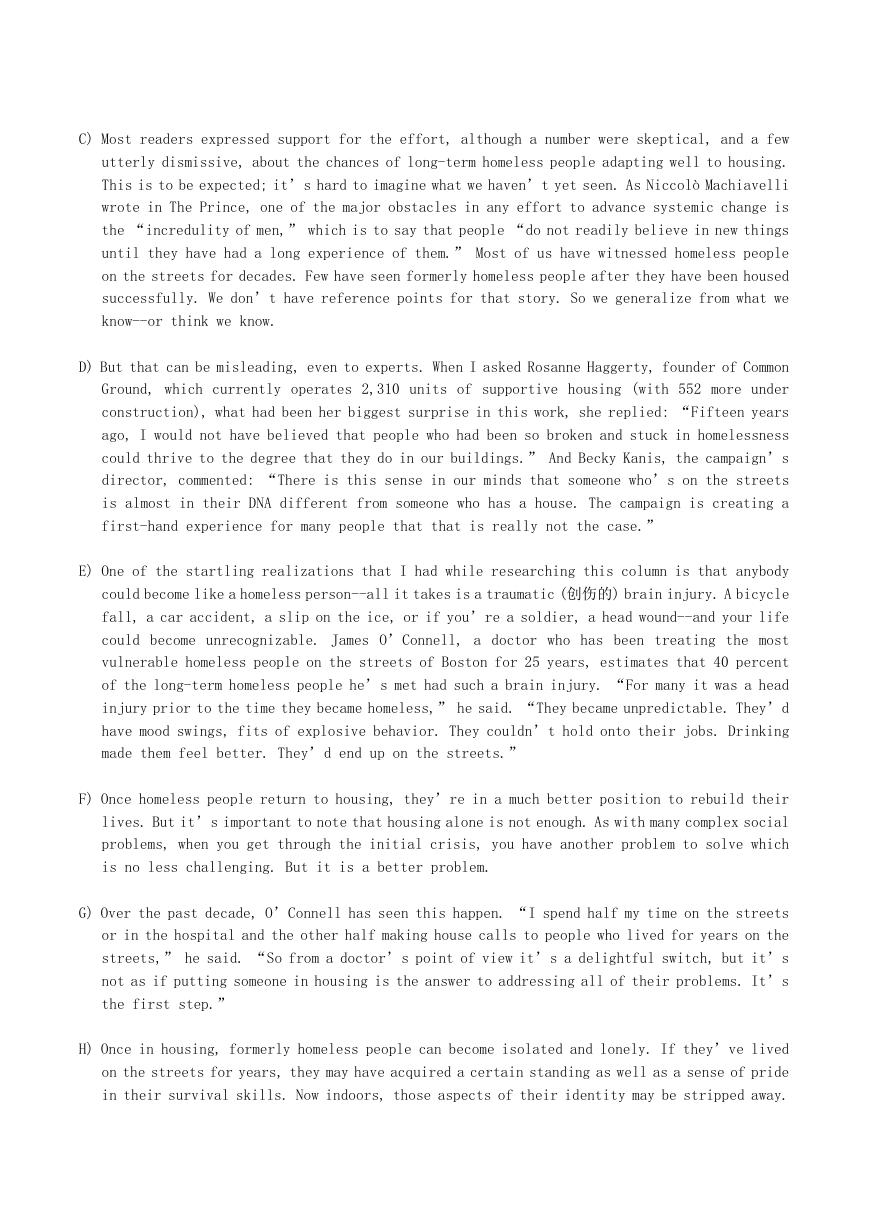










 2023年江西萍乡中考道德与法治真题及答案.doc
2023年江西萍乡中考道德与法治真题及答案.doc 2012年重庆南川中考生物真题及答案.doc
2012年重庆南川中考生物真题及答案.doc 2013年江西师范大学地理学综合及文艺理论基础考研真题.doc
2013年江西师范大学地理学综合及文艺理论基础考研真题.doc 2020年四川甘孜小升初语文真题及答案I卷.doc
2020年四川甘孜小升初语文真题及答案I卷.doc 2020年注册岩土工程师专业基础考试真题及答案.doc
2020年注册岩土工程师专业基础考试真题及答案.doc 2023-2024学年福建省厦门市九年级上学期数学月考试题及答案.doc
2023-2024学年福建省厦门市九年级上学期数学月考试题及答案.doc 2021-2022学年辽宁省沈阳市大东区九年级上学期语文期末试题及答案.doc
2021-2022学年辽宁省沈阳市大东区九年级上学期语文期末试题及答案.doc 2022-2023学年北京东城区初三第一学期物理期末试卷及答案.doc
2022-2023学年北京东城区初三第一学期物理期末试卷及答案.doc 2018上半年江西教师资格初中地理学科知识与教学能力真题及答案.doc
2018上半年江西教师资格初中地理学科知识与教学能力真题及答案.doc 2012年河北国家公务员申论考试真题及答案-省级.doc
2012年河北国家公务员申论考试真题及答案-省级.doc 2020-2021学年江苏省扬州市江都区邵樊片九年级上学期数学第一次质量检测试题及答案.doc
2020-2021学年江苏省扬州市江都区邵樊片九年级上学期数学第一次质量检测试题及答案.doc 2022下半年黑龙江教师资格证中学综合素质真题及答案.doc
2022下半年黑龙江教师资格证中学综合素质真题及答案.doc